
Source: Getty Images
For years, inflation has been too low for comfort for the world’s major central banks. Inflation remained elusive despite ultra-accommodative policy through negative interest rates and an eye-watering amount of quantitative easing (QE). It wasn’t until a pandemic that shuttered economies and ground supply chains to a halt, a war that raised geopolitical tensions and damaged global food and energy security, and a further increase in money supply in response ,that inflation moved meaningfully higher. The question is, is it here to stay?
Inflation is the measurement of the price change for goods and services. As prices start to find a level and stop increasing, the year on year (YoY) change will eventually trend to zero. We will begin seeing these ‘base effects’ drop out, and inflation will start behaving.
Covid is now thankfully a distant memory, and supply chains have eased and are now back to ‘normal’ – a disinflationary impulse.
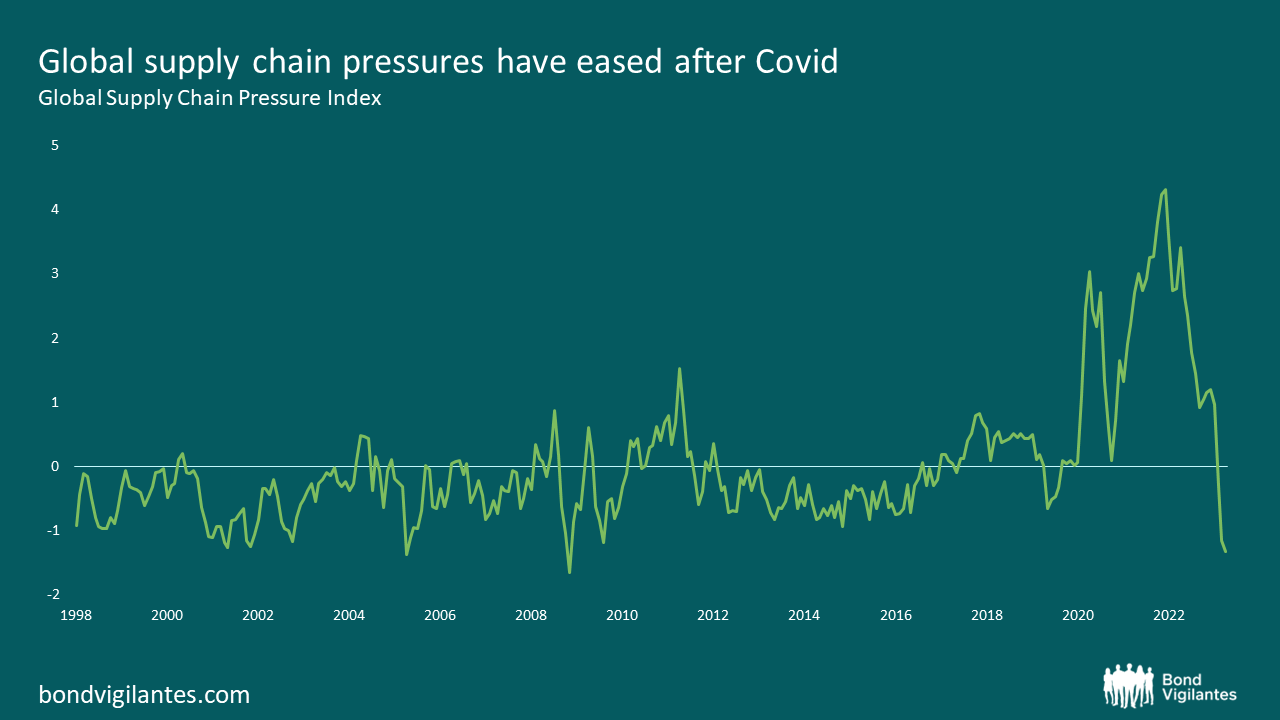
Source: Bloomberg (May 2023)
The energy-induced spike from Putin’s invasion of Ukraine has eased and is another disinflationary impulse.
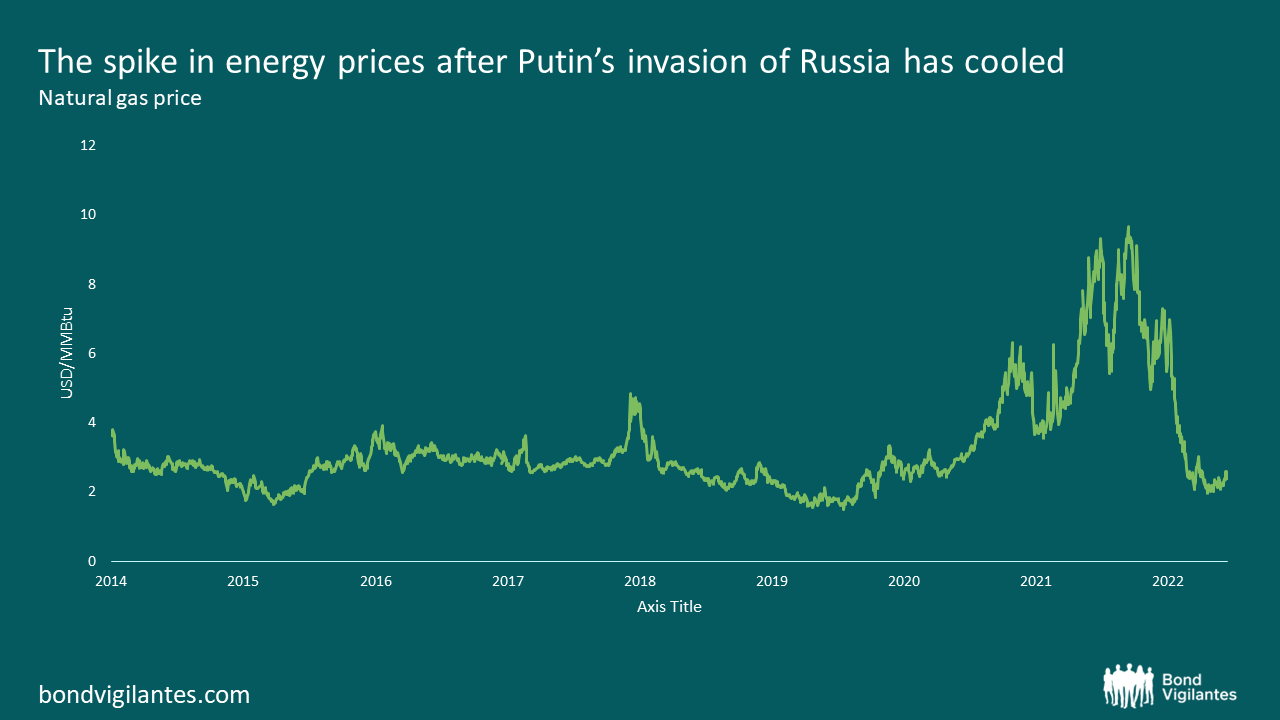
Source: Bloomberg (May 2023)
The aggressive rate hiking cycle the Bank has embarked on should bring about a slowdown in growth. This is particularly acute for economies with housing exposure linked to floating-rate mortgage products, less of a concern for the US, as most will have 30yr fixed mortgages. With house prices at unaffordable levels across most of the developed world and the cost of borrowing moving sharply higher, house prices will undoubtedly be pressured downwards, another disinflationary impulse. Alongside the housing market, the commercial real estate (CRE) sector is particularly vulnerable as it grapples with tighter monetary policy and a cascade of debt maturities. Rolling the debt over will hurt profitability as the cost of funding is now higher, but also potentially very difficult to do in the current environment. Regional banks in the US are going through their own crisis and are responsible for circa 70% of US CRE lending. Look out below.
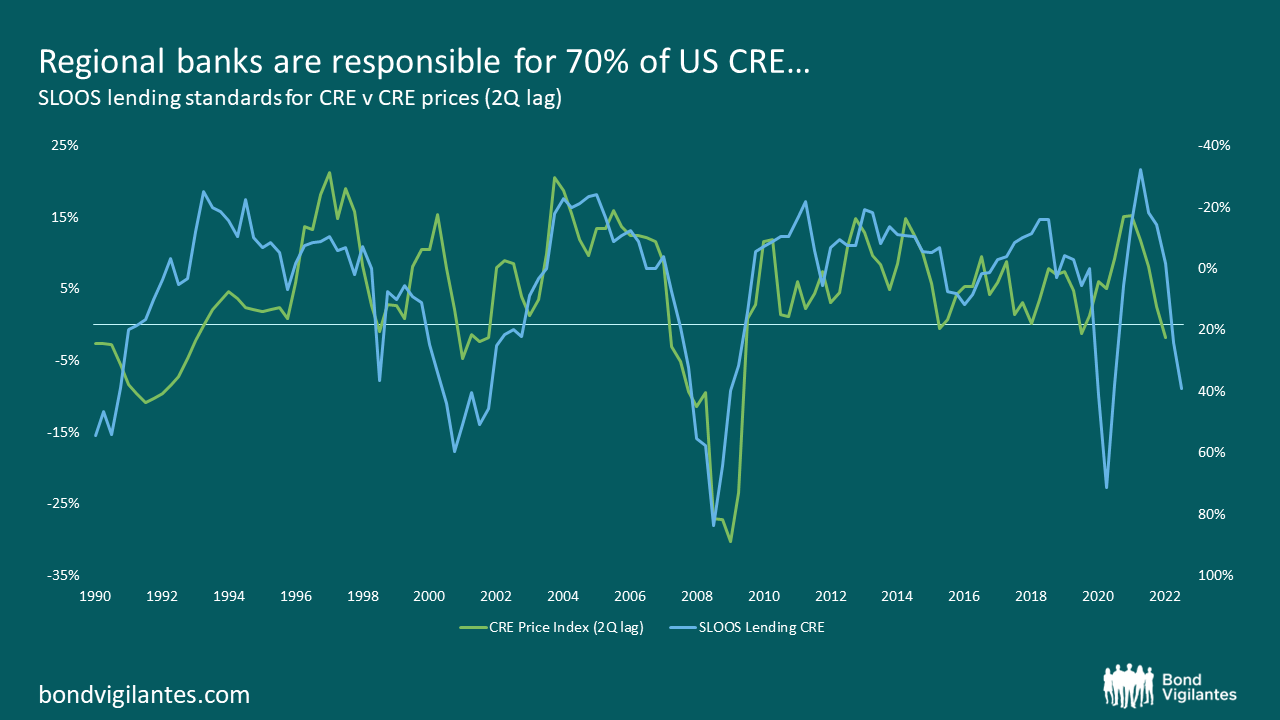
Source: St Louis Federal Reserve (March 2023)
Perhaps the market has avoided a nasty recession to date as the consumer has remained defiant and run down their savings and significantly increased credit card debt over the past few years. The ability to do so going forward seems limited given savings rates are at or near the lows and credit card debt is at record highs with increasing annual percentage rates (APRs).
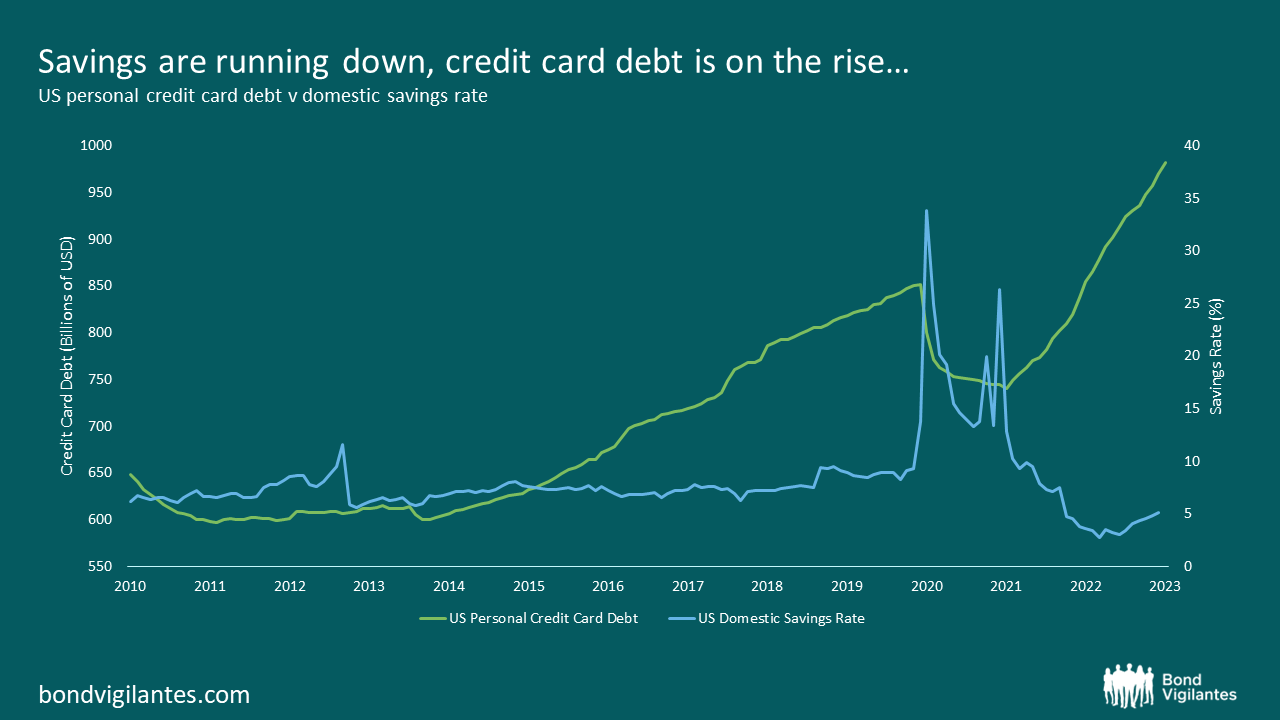
Source: Bloomberg (May 2023)
What is the market pricing? The ‘market’ has a particularly gloomy outlook and suspects recession is all but assured. The 2s/10s yield curve has been an accurate predictor of recession in the past and is currently highly inverted, signalling recession risk.
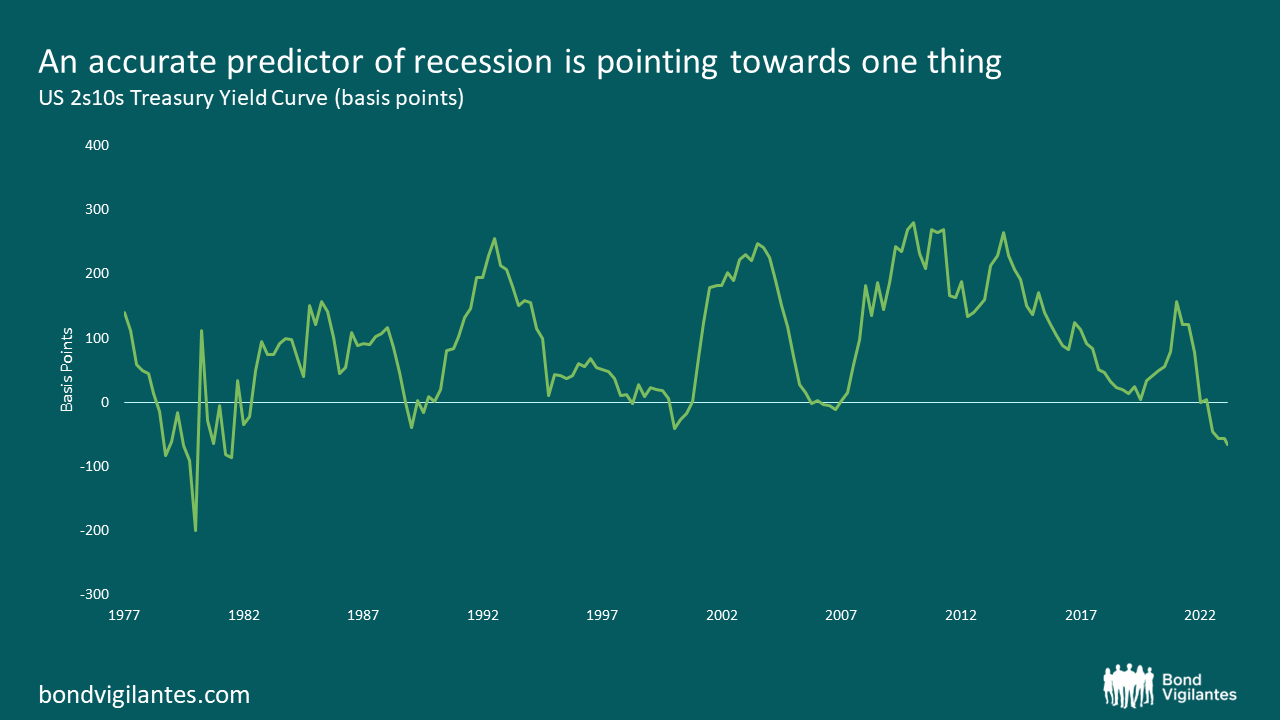
Source: Bloomberg (May 2023)
On the other hand, the Fed needs to engender confidence; they have said that the spread between 18m forward 3m and spot 3m yield is a better indicator and inferred that recession was less likely. I’m not here to say which measure is better, but… the Fed’s measure has rolled over in spectacular fashion and now suggests the same. That was quick.
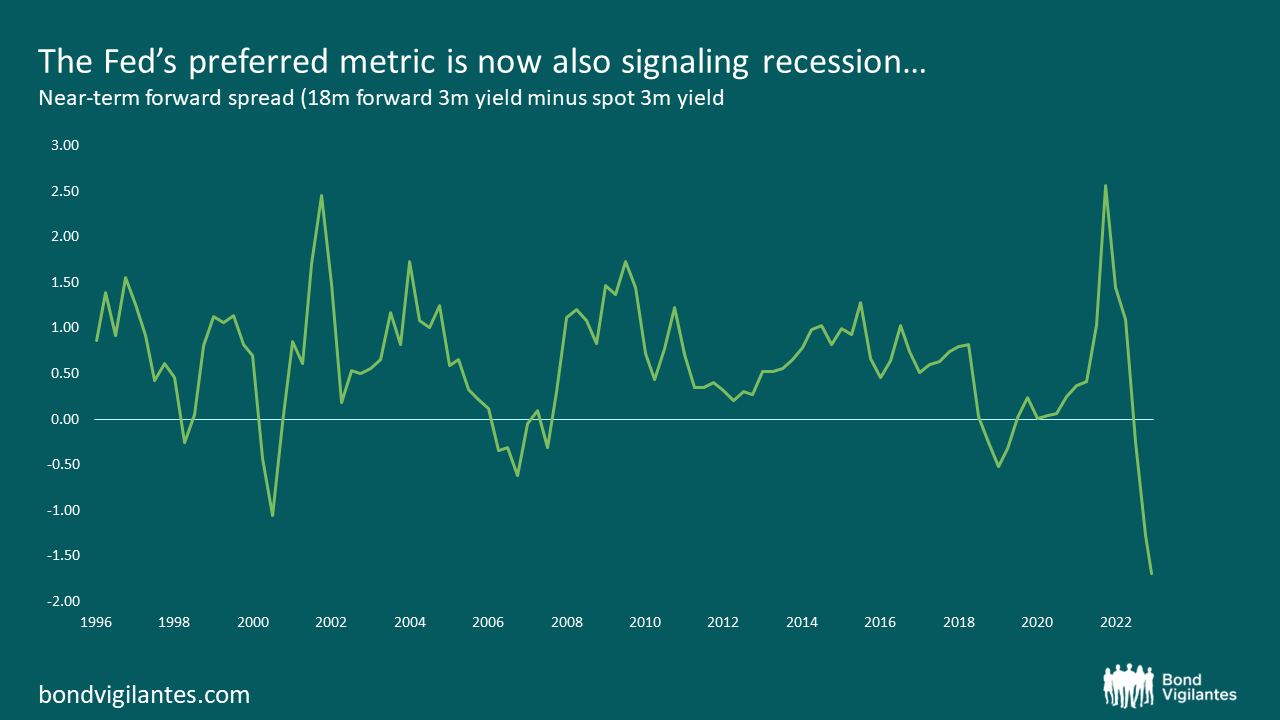
Source: Bloomberg (May 2023)
Perhaps the biggest threat to inflation is artificial intelligence (AI)
AI has been predicted to destroy up to 300 million jobs in the coming years. Possibly a doomsday scenario, perhaps not. Mo Gawdat’s bestselling business book of the year, ‘Scary Smart’ gives a splendid and balanced view of this new technology and its impact on humanity. Gawdat was the former chief engineer at Google X, so we can be confident that he has a deep understanding of the sector. Worryingly, this was published in 2021, and things have moved on since then. Several takeaways from the book which struck a chord with me are:
Read the book, it really is terrifying.
Is this all scaremongering? Well, there must be something to this. Influential voices worldwide are pleading for regulation around the sector, but this is unlikely to meet its intended purpose. AI is simply progressing too quickly.
During the internet revolution, we witnessed Schumpeter’s creative destruction whereby the destruction of existing economic structures such as industries, firms and jobs were replaced by new ones via innovation and technological change. It always felt like a few industries were at risk, and if you weren’t in that industry, you could breathe a sigh of relief and move on happily with your life. This time it feels different. The breadth and scale of jobs now at risk are frightening.
A few examples are always helpful to help drive home the idea. Least at risk was always the Arts; this is no longer the case.

Source: Rob Burrows’ original creation
An employment earthquake could be on the near horizon. Mass unemployment is certainly not a recipe for rampant inflation. There may, however, be unchecked profits for those companies that benefit from AI and a cost-cutting drive. Not a bright outlook for the man on the street. How will we all survive while on the unemployment scrap heap?
If such drastic change is upon us, we must rethink everything we know about economics and how society functions—no wonder the topic of universal basic income has reared its head again.
The value of investments will fluctuate, which will cause prices to fall as well as rise and you may not get back the original amount you invested. Past performance is not a guide to future performance.
For Investment Professionals only. Not for onward distribution. No other persons should rely on the information contained within this blog. This blog provides commentary and views on bond markets. Prepared by M&G’s bond team, this information is aimed at investment professionals wishing to supplement their understanding of these markets. Information shown on the blog should not be taken as advice or a recommendation to make an investment decision.
This weblog does not represent the thoughts, intentions, plans or strategies of M&G plc or any associated companies. They are solely the author’s personal opinion.
Inappropriate comments will be deleted or edited at the author’s discretion.
This blog may contain, or be linked to, advice or statements from third parties. M&G make no representation as to the accuracy, completeness, timeliness or suitability of such information and we have not, and will not, review or update such information and caution you that any use made of such information is at your own risk. Some of the information contained on this blog may also have been prepared or provided by third parties and may not have been verified by us. M&G hereby exclude any liability arising out of any preparation or provision of such information for this blog and make no warranty as to the accuracy, suitability or completeness of any such information.
With the exception of iviewtv.com, the links we provide from this blog to other websites are provided for information only. We do not assume any responsibility or liability with respect to any website accessed via our blog. We do not monitor or review any of the websites accessible through these links. Once you have used these links to leave this blog you should note that we do not have any control over that other website. We therefore cannot be responsible for the protection and privacy of any information that you provide whilst visiting such websites and such websites are not governed by our Terms & Conditions. You should exercise caution and look at the privacy statement applicable to the website in question.
The presence of any advert on this blog is not an endorsement by M&G of the goods, services or website advertised.
No liability is assumed for any use, or misuse, of the information presented on this blog.
As you are probably aware, internet email cannot be guaranteed and is not secure. We recommend that you do not send any confidential information to us by email. If you choose to send any confidential information then you do so at your own risk. Instructions sent by you via email, and to this blog, are processed exclusively at your risk.
Whilst M&G uses every reasonable effort to maintain the availability of this blog we cannot guarantee this. This blog may also change from time to time and we cannot guarantee the continuation of the services offered through it.